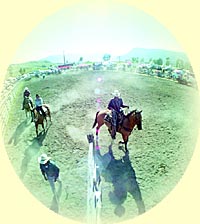Cowboys working on ranches or cattle drives have always watched each other and judged each other's skills in breaking and training horses, roping calves, and separating the cattle and horse herds. Friendly competitions originated from these everyday tasks. No one seems to know when the first Native rodeo was held, but Native communities had been raising and breaking horses, and holding competitions involving their horses for many generations before rodeo began. Rodeo gradually became a sport. At first, Native cowboys participated in local competitions on reserves and in nearby towns. As the sport grew, so did their involvement, and Native rodeo associations eventually emerged. Today, rodeo attracts working cowboys and professional athletes, many of whom excelled in other sports but find a special appeal in rodeo. The level of judging and competition, the type of prizes awarded and the quality of the rodeo stock have also become more professional. Introduction | What makes Native Rodeo Different? | History of Rodeo Associations | Rodeo Heroes | The Rodeo Arena | The Rodeo Circuit | Rodeo Events | Down the Road SACRED BEINGS | RANCHING | ENTERTAINMENT | RODEO | ARTS AND INDUSTRIES |

